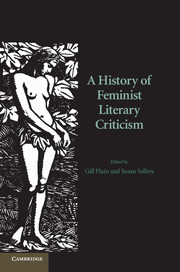Book contents
- Frontmatter
- Contents
- Acknowledgements
- Notes on contributors
- Introduction
- PART I PIONEERS AND PROTOFEMINISM
- PART II CREATING A FEMINIST LITERARY CRITICISM
- Introduction to Part II
- 6 Literary representations of women
- 7 A history of women's writing
- 8 Autobiography and personal criticism
- 9 Black feminist criticism
- 10 Lesbian feminist criticism
- 11 Men and feminist criticism
- PART III POSTSTRUCTURALISM AND BEYOND
- Postscript: flaming feminism?
- Index
- References
10 - Lesbian feminist criticism
Published online by Cambridge University Press: 05 June 2012
- Frontmatter
- Contents
- Acknowledgements
- Notes on contributors
- Introduction
- PART I PIONEERS AND PROTOFEMINISM
- PART II CREATING A FEMINIST LITERARY CRITICISM
- Introduction to Part II
- 6 Literary representations of women
- 7 A history of women's writing
- 8 Autobiography and personal criticism
- 9 Black feminist criticism
- 10 Lesbian feminist criticism
- 11 Men and feminist criticism
- PART III POSTSTRUCTURALISM AND BEYOND
- Postscript: flaming feminism?
- Index
- References
Summary
Any historical account of lesbian feminist criticism must, sooner or later, grapple with a myth of origins. The myth itself is not always the same, but certain features remain constant. I could begin by invoking Laura Doan's keynote address to the international Lesbian Lives conference in Dublin in 2004, a conference marking ten years of lesbian lives, studies and activism since the publication of Doan's critical anthology, The Lesbian Postmodern. In her conference speech, Doan emphasised the need to create a new genealogical model of lesbian studies and to dislodge what she called ‘this now calcified origin narrative’: the narrative of lesbian feminism's collision with, and defeat by, queer theory (Doan, 2004). Other participants at the conference – Linda Garber and Paulina Palmer, for example – likewise voiced their dissent from this dominant narrative, pointing out the unacknowledged connections between lesbian feminist thought and queer theory, and the injustice of the narrative's stereotypes: queer theory as ‘sexy, vital, pluralistic and fun’, lesbian feminism as the opposite (Palmer, 2004).
Ten years earlier, a different yet strikingly similar myth of origins was dominating lesbian and gay studies, as Kathleen Martindale noted: the story of ‘how the American feminist sex wars over sexual representation in the early 1980s created lesbian category trouble, broke up the feminist consensus, realigned lesbians with gay men and then brought forth the newest kid on the block: lesbian postmodernism’ (Martindale, 1997: 1).
- Type
- Chapter
- Information
- A History of Feminist Literary Criticism , pp. 169 - 186Publisher: Cambridge University PressPrint publication year: 2007

